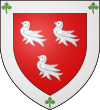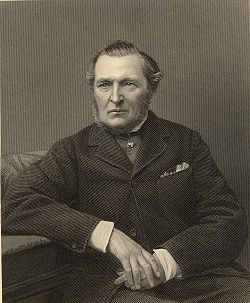
Earl of Longford is a title that has been created twice in the Peerage of Ireland.

Hugh McCalmont Cairns, 1st Earl Cairns was an Anglo-Irish statesman who served as Lord High Chancellor of Great Britain during the first two ministries of Benjamin Disraeli. He was one of the most prominent Conservative statesmen in the House of Lords during this period of Victorian politics. He served as the seventeenth Chancellor of the University of Dublin between 1867 and 1885.

Earl of Carlisle is a title that has been created three times in the Peerage of England.

Marquess of Downshire is a title in the Peerage of Ireland. It was created in 1789 for Wills Hill, 1st Earl of Hillsborough, a former Secretary of State.

Marquess of Donegall is a title in the Peerage of Ireland held by the head of the Chichester family, originally from Devon, England. Sir John Chichester sat as a Member of Parliament and was High Sheriff of Devon in 1557. One of his sons, Sir Arthur Chichester, was Lord Deputy of Ireland from 1605 to 1616. In 1613, he was raised to the Peerage of Ireland as Baron Chichester, of Belfast in County Antrim. He died childless in 1625 when the barony became extinct.

Marquess of Exeter is a title that has been created twice, once in the peerage of England and once in the peerage of the United Kingdom. The first creation came in the peerage of England in 1525 for Henry Courtenay, 2nd Earl of Devon. For more information on this creation, which was forfeited in 1538, see Earl of Devon.

Marquess of Cholmondeley is a title in the Peerage of the United Kingdom. It was created in 1815 for George Cholmondeley, 4th Earl of Cholmondeley.

Earl of the Island of Jersey, usually shortened to Earl of Jersey, is a title in the Peerage of England. It is held by a branch of the Villiers family, which since 1819 has been the Child Villiers family.

Earl Bathurst, of Bathurst in the County of Sussex, is a title in the Peerage of Great Britain.
Earl Fortescue is a title in the Peerage of Great Britain that was created in 1789 for Hugh Fortescue, 3rd Baron Fortescue (1753–1841), a member of parliament for Beaumaris and Lord-Lieutenant of Devon.

Viscount Falmouth is a title that has been created twice, first in the Peerage of England, and then in the Peerage of Great Britain. The first creation came in the Peerage of England in 1674 for George FitzRoy, an illegitimate son of King Charles II by Barbara Villiers. He was created Earl of Northumberland at the same time and in 1683 he was made Duke of Northumberland. However, he left no heirs, so the titles became extinct at his death in 1716.

Earl Nelson, of Trafalgar and of Merton in the County of Surrey, is a title in the Peerage of the United Kingdom. It was created on 20 November 1805 for the Rev. William Nelson, 2nd Baron Nelson, one month after the death of his younger brother Vice-Admiral Horatio Nelson, 1st Viscount Nelson, the famous naval hero of the Napoleonic Wars and victor of the Battle of Trafalgar of 21 October 1805. The title is extant, the present holder being Simon Nelson, 10th Earl Nelson, who has an heir apparent. The family seat of Trafalgar House in Wiltshire was sold in 1948 by Edward Nelson, 5th Earl Nelson.

Earl Belmore is a title in the Peerage of Ireland that was created in 1797 for Armar Lowry-Corry, 1st Viscount Belmore, who had previously represented County Tyrone in the Irish House of Commons. He had already been created Baron Belmore, of Castle Coole in County Fermanagh, in 1781 and Viscount Belmore in 1789, also in the Peerage of Ireland. Born Armar Lowry, he was the son of Galbraith Lowry, Member of the Irish House of Commons for County Tyrone, and his wife Sarah, daughter of Colonel John Corry. In 1774, he assumed by Royal licence the additional surname of Corry. He was succeeded by his eldest son, the second Earl. He represented County Tyrone in both the Irish and British House of Commons, sat in the House of Lords as an Irish Representative Peer from 1819 to 1841, and served as Governor of Jamaica from 1828 to 1832.

Earl of Lonsdale is a title that has been created twice in British history, firstly in the Peerage of Great Britain in 1784, and then in the Peerage of the United Kingdom in 1807, both times for members of the Lowther family.

Earl of Antrim is a title that has been created twice, both times in the Peerage of Ireland and both times for members of the MacDonnell family, originally of Scottish origins.

Earl Cawdor, of Castlemartin in the County of Pembroke, is a title in the Peerage of the United Kingdom. It was created in 1827 for John Campbell, 2nd Baron Cawdor.

Baron O'Neill, of Shane's Castle in the County of Antrim, is a title in the Peerage of the United Kingdom. It was created in 1868 for the musical composer The Reverend William O'Neill. Born William Chichester, he succeeded to the estates of his cousin John Bruce Richard O'Neill, 3rd Viscount O'Neill, in 1855 and assumed by Royal licence the surname of O'Neill in lieu of Chichester in order to inherit the lands of his cousin, despite not being descended in the male line from an O'Neill. The Chichesters trace their lineage to the name O'Neill through Mary Chichester, daughter of Henry O'Neill of Shane's Castle. Lord O'Neill was the patrilineal great-great-great-grandson of John Chichester, younger brother of Arthur Chichester, 2nd Earl of Donegall. The latter two were both nephews of Arthur Chichester, 1st Earl of Donegall, and grandsons of Edward Chichester, 1st Viscount Chichester. Lord O'Neill was succeeded by his eldest son, the second Baron. He sat as a Conservative Member of Parliament for Antrim.
Baron Rathcavan, of The Braid in the County of Antrim, is a title in the Peerage of the United Kingdom. It was created on 11 February 1953 for the Unionist politician Sir Hugh O'Neill, 1st Baronet. He had already been created a Baronet, of Cleggan in the County of Antrim, on 17 June 1929. O'Neill was the third son of Edward O'Neill, 2nd Baron O'Neill and the uncle of the Prime Minister of Northern Ireland Terence O'Neill, Baron O'Neill of the Maine. Lord Rathcavan was also a male-line descendant of Edward Chichester, 1st Viscount Chichester. He was succeeded by his eldest surviving son, the second Baron. He succeeded his father as Unionist Member of Parliament for Antrim in 1952, a seat he held until 1959, and was later a member of the Parliament of Northern Ireland. As of 2014 the titles are held by his son, the third Baron, who succeeded in 1994.

Arthur William Cairns, 2nd Earl Cairns, was a British aristocrat, succeeding to the title on the death of his father, the first Earl Cairns, on 2 April 1885.

Earl of Arran is a title in the Peerage of Ireland. It is not to be confused with the title Earl of Arran in the Peerage of Scotland. The two titles refer to different places: the Aran Islands in Ireland, and the Isle of Arran in Scotland. The Irish earldom is held by the Gore family. The Scottish earldom is a separate title, held as a subsidiary title of the Duke of Hamilton.













